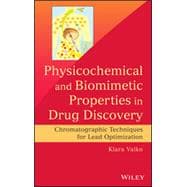Demonstrating how and why to measure physicochemical and biomimetic properties in early stages of drug discovery for lead optimization, Physicochemical and Biomimetic Properties in Drug Discovery encourages readers to discover relationships between various measurements and develop a sense of interdisciplinary thinking that will add to new research in drug discovery. This practical guide includes detailed descriptions of state-of-the-art chromatographic techniques and uses real-life examples and models to help medicinal chemists and scientists and advanced graduate students apply measurement data for optimal drug discovery.








